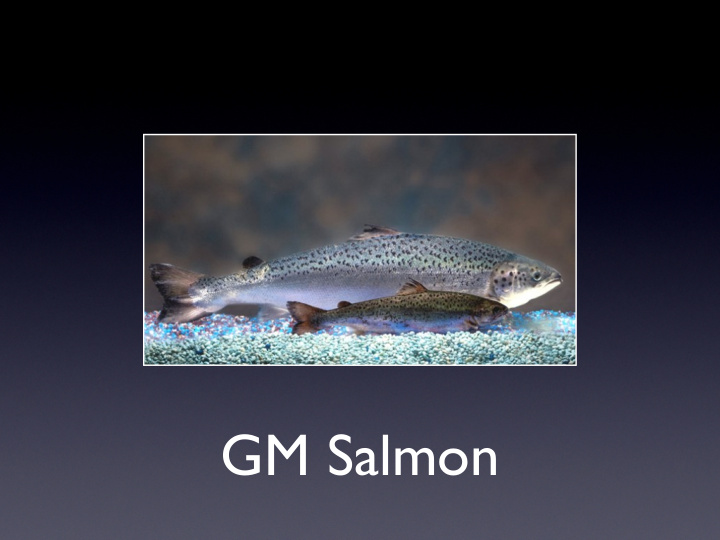



GM Salmon
Why GMO? • output from fisheries has effectively hit a ceiling since the mid-1980s • any growth in seafood consumption is due to aquaculture • improving aquaculture output to keep up with growing populations, appetites, preferences
World Population 8,801 9,150 8,309 7,675 6,909 6,909 5,978 2,521 1,262 1,650 978 791 682 1700 1750 1800 1850 1900 1950 2000 2010 2020 2030 2040 2050 Estimated (millions) Projected (millions)
Population by Region Asia Africa Europe Latin America Northern America Oceania 10,000 7,500 (millions) 5,000 2,500 0 2000 2005 2010 2015 2020 2025 2030 2035 2040 2045 2050
Northern America *excludes Mexico 448 440 431 421 410 398 383 368 352 335 319 2000 2005 2010 2015 2020 2025 2030 2035 2040 2045 2050
Consumption Rates Average Daily Per Capita 4,000 3500 3440 kilocalories (food calories) 3380 3206 3,000 3065 3050 2947 2940 2803 2655 2435 2358 2,000 1,000 0 1965 1975 1985 1998 2015 2030 Global Industrialized Countries
Global Total Daily Consumption 30 teracalories (10^12 calories) 25.3 22.5 21.4 16.7 15 12.8 9.91 7.5 7.86 0 1965 1975 1985 1998 2015 2030 25.3 teracalories = .106 exajoules (10 18 joules)
Energy Consumption
Relative Energy 1 Day Consumption (2030) 0.106 Tsar Bomba (50 megaton) 0.2 Japanese Earthquake (9.0 Richter) 1.41 1 Month Consumption (2030) 3.18 exajoules (10 18 joules)
Aquaculture
Aquaculture Issues • Solid Waste and Effluent Pollution • uneaten food and waste fall to the ocean floor and build up • bacteria attempt to break down the sediment, lowering O 2 in the water • Baggiatoa form in absence of O 2 and HSO 4 and CH 4 are released through anaerobic decomposition – toxic
Aquaculture Issues • Chemical Pollution • antifoulants incorporated into the materials of the netpens leach into the water – toxic to some sea life • pesticides used to control parasites effective at very low levels – deadly to crustaceans like the sea lice they seek to destroy
Aquaculture Issues • Solid Waste and Effluent Pollution • effluents rich in nitrogen and phosphorous lead to algae blooms which die and add to the sediments below • Chemical Pollution • antibiotics active in water hundreds of meters away from netpens for months – harmful to CNS, liver and promote antibiotic-resistance
Aquaculture Issues • Escapees may • compete with native species for space and food • may spread parasites or disease to native species or other aquaculture facilities
GM Aquaculture • fish grow more rapidly – food, pesticides, antibiotics used at a greater rate and/or greater quantities as pens have higher turnover rates • escapees may be significantly more harmful due to their increased space and food requirements
Aquaculture Issues • Escapees may • interbreed • hybridizatize
Existing Laws • Animal Protection • Nonindigenous and/or Invasive • Major environmental laws
Animal Protection • Animal Health Protection Act • protects “livestock” (farm-raised animals) or related industries • from “pests” or “any organism…allied” • regulates pest “articles” – harbor “pests”
Animal Protection • Animal Health Protection Act • prohibits “export” via “move” • “export” – extra territorial or interstate move • “move” – includes “release to environment”
Animal Protection • Animal Health Protection Act • GM salmon may be pests through alliance with actual pests (eg. sea lice) • GM salmon may be “articles” as they harbor pests or “disease” • “disease” broadly interpreted by the secretary…gene transmission?
Animal Protection • Animal Damage Control Act • originally passed to contol damage from wildlife predators • protects fisheries and aquaculture • GM salmon may exhibit predatory characteristics, causing loss to fishery and aquaculture operations
Nonindigenous/Invasive • Nonindegenous Aquatic Nuisance Prevention and Control Act • purpose to prevent unintentional spread of nonindigenous species through ballast water or other pathways
Nonindigenous/Invasive • Nonindegenous Aquatic Nuisance Prevention and Control Act, amended by National Invasive Species Act • “nonindigenous species” any species or viable bilogical material that enters an ecosystem beyond its historic range
Nonindigenous/Invasive • Nonindegenous Aquatic Nuisance Prevention and Control Act • “aquatic nuisance species” nonindgenous species that threatens diversity and abundance of native species or ecological stability of infested waters, or commercial, aquacultural…activities
Nonindigenous/Invasive • Nonindegenous Aquatic Nuisance Prevention and Control Act • creates inter-agency task force to identify and prevent the nonindigenous and nuisance aquatic species
Nonindigenous/Invasive • Nonindegenous Aquatic Nuisance Prevention and Control Act • Michigan v. U.S. Army Corps of Engineers (2010) • multiple states – Michigan, Wisconsin, Minnesota, Ohio, and Pennsylvania sued Corps to take action under prevent Asian Carp from entering Great Lakes
Nonindigenous/Invasive • Executive Order 13112 • creates another inter-agency body – the Invasive Species Council • designed to prevent introduction of invasive species and if introduced, respond to control their populations
Environmental Laws • Clean Water Act • individual fish (or humans/animals) are not “point sources” • netpens, however, have been found to be “point sources” • feces, urine, antifoulants, other additives, pesticides, antibiotics – all “pollutants”
Environmental Laws • Clean Water Act • United States Public Interest Research Group v. Atlantic Salmon of Maine, LLC • found non-native fish to be “pollutants” within the meaning of the CWA • proof that pollutant causes harm not required
Environmental Laws • Endangered Species Act • potential takings due to effects of aquaculture facilities in general, and in the estimation of some (GM salmon even riskier more resource-intensive than regular aquaculture), more pronounced
Existing Laws Destructive Nonindigenous Neither Animal Protection NI or Invasive CWA ESA Potential Criminal Penalties
Thanks. Questions?
Recommend
More recommend